Serious shortage and many impacts on seaport human resources
Human resource demand is affected by technology trends
According to the Vietnam Port Skills Forecast 2024-2028 report conducted by the Logistics Industry Reference Council (LIRC) funded by the Australian Department of Foreign Affairs and Trade (DFAT) through the Australia-Vietnam Human Resources Development Program (Aus4Skills); supported by the General Department of Vocational Education and Training (DVET) and the Vietnam Federation of Commerce and Industry - Ho Chi Minh City branch, human resources at Vietnamese seaport enterprises for the vehicle and equipment control sector and the exploitation, engineering, and loading and unloading sector (direct labor) are always in a serious shortage.
In particular, the positions that are lacking in personnel due to difficulty in recruitment are the vehicle and equipment control sector such as cranes, frame cranes, and tractors; personnel in the exploitation, engineering, and loading and unloading sectors such as inspection, repair, and maintenance of container loading and unloading equipment, etc.
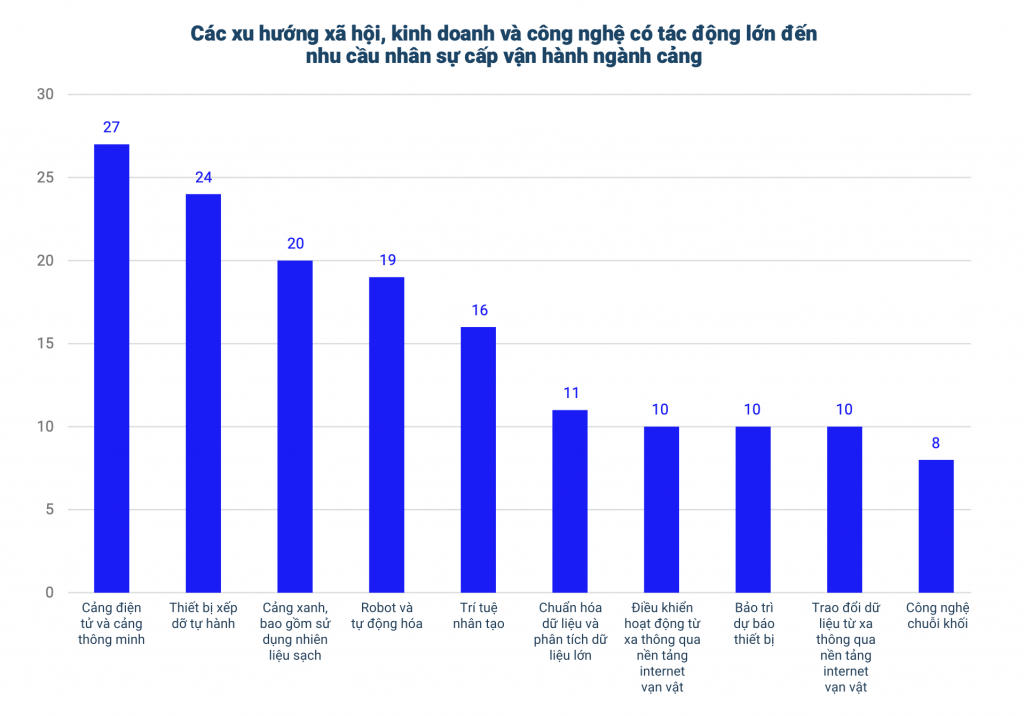 |
| Source: Vietnam Port Industry Skills Forecast Report 2024-2028. |
Explaining the reasons for the difficulty in recruiting personnel, citing opinions from businesses, the report said that due to candidates' lack of experience, knowledge and professional skills; few state-owned educational institutions providing training in the port industry; lack of specialized vocational certificates; harsh working time and environment; competitive salaries; long-term commitment requirements.
The report also identified five trends in the port industry's development in the 2024-2028 period that have a clear impact on personnel needs at the port operations level, including: electronic ports and smart ports; autonomous loading and unloading equipment; green ports (using clean fuel); robots and automation; artificial intelligence (AI).
The report states that these are green technology trends that are consistent with the Government's integration and development strategy with the goal of turning Vietnam into a strong maritime nation, in which the task of developing the seaport system is an important task. The above technology trends will strongly impact the change in human resource needs in the Vietnamese seaport system in the future. According to the assessment of seaport enterprises in Vietnam, from 2024-2028, the human resource sectors at seaports will have strong changes in demand, especially at the levels of equipment and vehicle operation and direct exploitation and technical levels at the port due to the impact of technology trends that meet the task of developing the seaport economy in Vietnam.
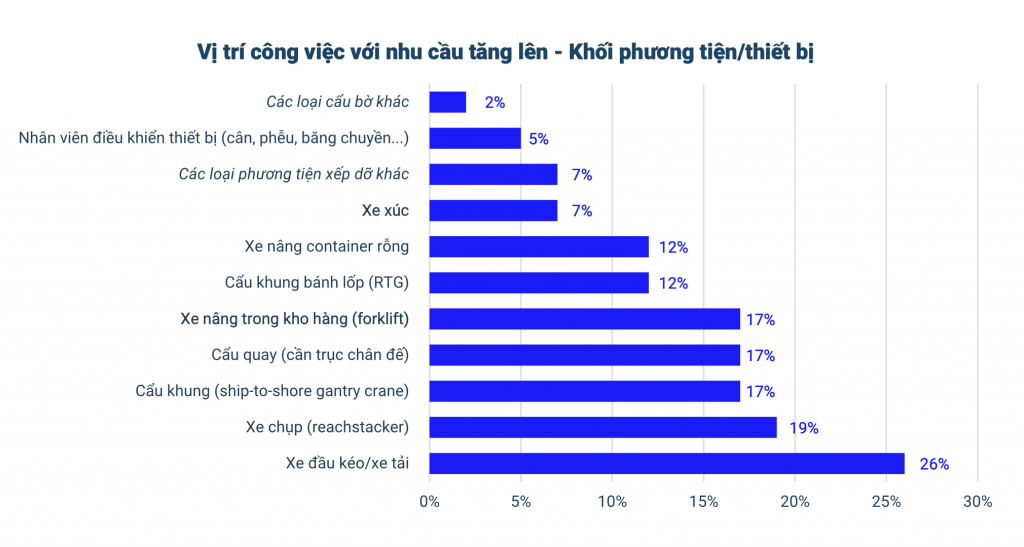 |
| Source: Vietnam Port Industry Skills Forecast 2024-2028 report. |
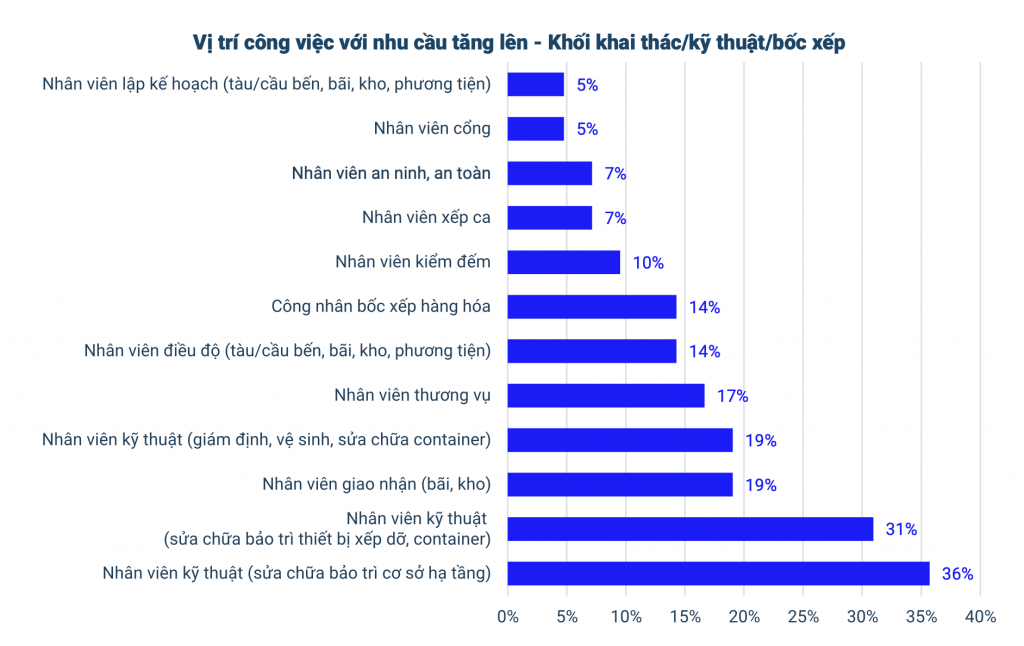 |
| Source: Vietnam Port Industry Skills Forecast 2024-2028 report. |
The survey results show that the correlation between the development trends of seaports in the coming time is related to digitalization, automation and technology, especially in the means of operating equipment at ports. These trends have been and are happening rapidly, requiring human resources to be trained with appropriate qualifications and skills, especially human resources at local ports.
Proactively cooperate to solve the problem of labor shortage
Given the current situation of insufficient and weak human resources in seaports, the report recommends that central-level state management agencies should supplement and clarify in detail the tasks of relevant parties in the industry regarding the content of human resource training and improving the skills of port workers in Decision No. 1579/QD-TTg dated September 22, 2021 of the Prime Minister on the Master Plan for the Development of Vietnam's Seaport System for the 2021-2030 period, with a vision to 2050.
At the same time, consider including the content of training, retraining, and training of port and seaport skills in the training and skills development programs at vocational training institutions. Institutionalize the model of engaging businesses in skills training and human resource development through the Vocational Skills Council.
The report recommends that local authorities should improve their capacity for forecasting, statistics and planning to develop human resources with vocational skills suitable to the requirements of the local labor market, especially future skills, new industries and occupations related to ports and seaports. Encourage and facilitate vocational training institutions and enterprises to register to train in port industries and occupations suitable to the requirements of local socio-economic development.
The report suggests that enterprises should proactively cooperate with vocational training institutions in training human resources by providing information on recruitment needs, knowledge, skills and attitude requirements for specific job positions. This will serve as a basis for state management agencies to adjust policies, targets and related training standards as well as help schools adjust training programs to ensure the quality of training output is close to the actual needs of enterprises and the development trends of the industry.
According to the report, the deep participation of enterprises in training activities from participating in the development of occupational standards, giving opinions, developing training programs at enterprises and evaluating student quality... helps enterprises proactively solve the problem of labor shortage for production activities and business development of enterprises.
Related News

Border gate planning: Issues for Lang Son
10:02 | 17/12/2024 Headlines

Enhancing the role of localities in developing supporting industries
12:31 | 15/09/2024 Import-Export

FDI enterprises maintain their own advantages to retain high-quality human resources
08:29 | 04/09/2024 Import-Export
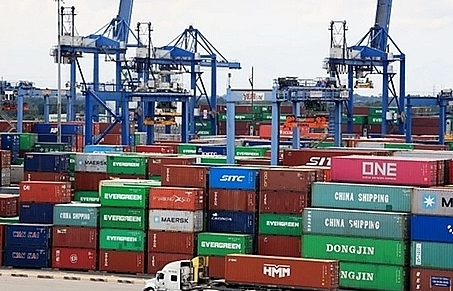
Creating a breakthrough for the development of Ho Chi Minh City's service industry
10:19 | 09/08/2024 Import-Export
Latest News

UK a niche market for Vietnamese speciality coffee
14:11 | 23/12/2024 Import-Export

Vietnam-US trade thrives on effective mechanisms: trade counsellor
14:08 | 23/12/2024 Import-Export

Opening of overseas markets boosts coconut exports
13:59 | 23/12/2024 Import-Export

Increasing consumption demand, steel enterprises face many opportunities
11:08 | 23/12/2024 Import-Export
More News

VN faced with increasing trade defence investigations on rising protectionism
18:58 | 22/12/2024 Import-Export

Việt Nam expects to officially export passion fruit to the US next year
18:55 | 22/12/2024 Import-Export

UK’s carbon tax to affect VN exports
18:51 | 22/12/2024 Import-Export

Removing obstacles in granting certificates of exploited aquatic products
13:56 | 22/12/2024 Import-Export

Promoting agricultural exports to the Japanese market
13:55 | 22/12/2024 Import-Export

Agricultural exports in 2024 to exceed 60 billion USD?
13:53 | 22/12/2024 Import-Export

Seafood exports expected to exceed $10 billion in 2025: expert
20:28 | 21/12/2024 Import-Export
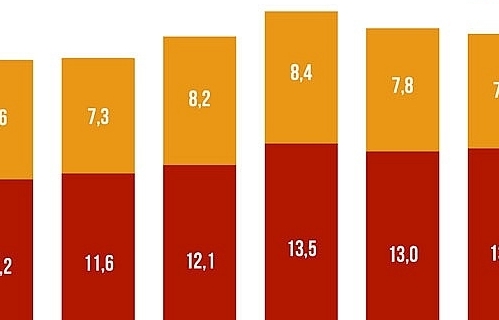
Top 10 Reputable Animal Feed Companies in 2024: Efforts to survive the challenges of nature
18:30 | 21/12/2024 Import-Export

Vietnam's import-export surges 15.3%
09:44 | 20/12/2024 Import-Export
Your care

UK a niche market for Vietnamese speciality coffee
14:11 | 23/12/2024 Import-Export

Vietnam-US trade thrives on effective mechanisms: trade counsellor
14:08 | 23/12/2024 Import-Export

Opening of overseas markets boosts coconut exports
13:59 | 23/12/2024 Import-Export

Increasing consumption demand, steel enterprises face many opportunities
11:08 | 23/12/2024 Import-Export

VN faced with increasing trade defence investigations on rising protectionism
18:58 | 22/12/2024 Import-Export




